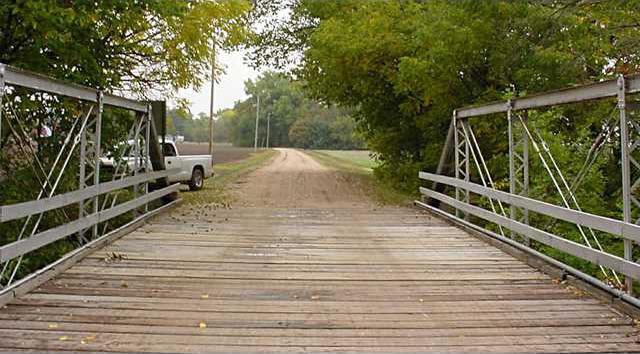Some call it the eastern spotted skunk and some call it the civit cat. Whatever one calls the small, black, furry critter, it calls a bridge southeast of Great Bend home.
And there’s the rub. The skunk is considered an endangered animal and the old steel-truss bridge is, well, endangered too since it is targeted for replacement.
The bridge crosses the Walnut Creek about three miles east of Great Bend on East Barton County Road and about three quarters of a mile south. The last steel bridge in the county, it was moved to the location in 1945, but was built as many as 40 years before that.
It has been on the list for replacement for several years, Barton County Engineer Clark Rusco said.
However, “there is only one way in and one way out” for those who live south of the creek, he said. So, the plan calls for the new concrete slab bridge to be built 50 feet to the east, with the old span remaining in use until the new one is completed.
But, according to information from the Great Plains Nature Center in Wichita, Barton County is one of a handful of counties in Kansas considered a “critical” habitat for the rare skunk. It is rarely found in the Sunflower State and is fully protected as a threatened species under the Kansas Nongame and Endangered Species Conservation Act.
So, a couple weeks ago, Rusco met with a Kansas Department of Wildlife, Parks and Tourism official a concerning the permitting for the replacement of the original structure. “We have to do something to protect their habitat.”
Information from the KDWPT notes that any time a project is proposed that will impact the species’ preferred habitats, the project sponsor must contact the department’s Ecological Services Section in Pratt.
The agency official told Rusco KDWPT requires an action permit assuring the county will account for the spotted skunk. This permit, one of seven permits required for any such project, has to be approved by state and federal wildlife officers.
This could mean having to do something as simple as create a brush pile east of the site in which the skunks could reside. But, there could be more demanding requirements.
“The federal and the state governments will each tell what needs to be done,” Rusco said. “Who knows what they will say.”
Rusco could have an answer in a few weeks. He hopes bids for the project can be let in May.
The work will take about three months, with a majority of the cost being covered by the state.
Agriculture has changed dramatically, and small farms have nearly vanished along with the eastern spotted skunk. Pesticides like DDT may have also played a role in the long-term decline of this mammal.
Even though the striped skunk is common, the eastern spotted is rarely seen. Its black tail with a white tip, elongated white spots on its back and white spot on its forehead distinguish it from the striped skunk. It is adept at climbing trees and some old farmers refer to it as the civet cat.
RAISING A STINK
Habitat for endangered skunk may delay bridge project





